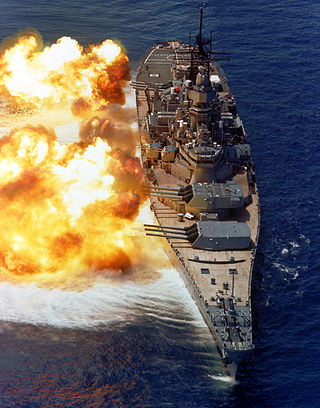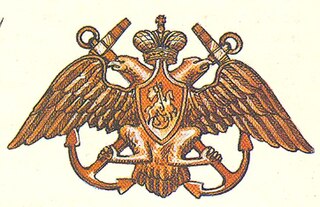Related Research Articles

A battleship is a large, heavily armored warship with a main battery consisting of large-caliber guns, designed to serve as capital ships with the most intense firepower. Before the rise of supercarriers, battleships were among the largest and most formidable weapon systems ever built.

A cruiser is a type of warship. Modern cruisers are generally the largest ships in a fleet after aircraft carriers and amphibious assault ships, and can usually perform several operational roles from search-and-destroy to ocean escort to sea denial.

In naval terminology, a destroyer is a fast, maneuverable, long-endurance warship intended to escort larger vessels in a fleet, convoy, or carrier battle group and defend them against a wide range of general threats. They were originally conceived in 1885 by Fernando Villaamil for the Spanish Navy as a defense against torpedo boats, and by the time of the Russo-Japanese War in 1904, these "torpedo boat destroyers" (TBDs) were "large, swift, and powerfully armed torpedo boats designed to destroy other torpedo boats". Although the term "destroyer" had been used interchangeably with "TBD" and "torpedo boat destroyer" by navies since 1892, the term "torpedo boat destroyer" had been generally shortened to simply "destroyer" by nearly all navies by the First World War.

A torpedo boat is a relatively small and fast naval ship designed to carry torpedoes into battle. The first designs were steam-powered craft dedicated to ramming enemy ships with explosive spar torpedoes. Later evolutions launched variants of self-propelled Whitehead torpedoes.

The Battle of Tsushima, also known in Japan as the Battle of the Sea of Japan, was the final naval battle of the Russo-Japanese War, fought on 27–28 May 1905 in the Tsushima Strait. A devastating defeat for the Imperial Russian Navy, the battle was the only decisive engagement ever fought between modern steel battleship fleets and the first in which wireless telegraphy (radio) played a critically important role. The battle was described by contemporary Sir George Clarke as "by far the greatest and the most important naval event since Trafalgar".

A warship or combatant ship is a ship that is used for naval warfare. Usually they belong to the navy branch of the armed forces of a nation, though they have also been operated by individuals, cooperatives and corporations. As well as being armed, warships are designed to withstand damage and are typically faster and more maneuverable than merchant ships. Unlike a merchant ship, which carries cargo, a warship typically carries only weapons, ammunition and supplies for its crew.

The Battle of Port Arthur of 8–9 February 1904 marked the commencement of the Russo-Japanese War. It began with a surprise night attack by a squadron of Japanese destroyers on the neutral Russian fleet anchored at Port Arthur, Manchuria, and continued with an engagement the following morning; further skirmishing off Port Arthur would continue until May 1904. The attack ended inconclusively, though the war resulted in a decisive Japanese victory.

"Ironbottom Sound" is the name given by Allied sailors to the stretch of water at the southern end of The Slot between Guadalcanal, Savo Island, and Florida Island of the Solomon Islands, because of the dozens of ships and planes that sank there during the naval actions comprising the Battle of Guadalcanal during 1942–1943. Before the war, it was called Savo Sound. Every year on the battle's anniversary, a US ship cruises into the waters and drops a wreath to commemorate the men who lost their lives. For many Navy sailors, and those who served in the area during that time, the waters in this area are considered sacred, and strict silence is observed as ships cruise through.

The Type 93 was a 610 mm (24 in)-diameter torpedo of the Imperial Japanese Navy (IJN), launched from surface ships. It is commonly referred to as the Long Lance by most modern English-language naval historians, a nickname given to it after the war by Samuel Eliot Morison, the chief historian of the U.S. Navy, who spent much of the war in the Pacific Theater. In Japanese references, the term Sanso gyorai is also used, in reference to its propulsion system. It was the most advanced naval torpedo in the world at the time.

The Imperial Russian Navy operated as the navy of the Russian Tsardom and later the Russian Empire from 1696 to 1917. Formally established in 1696, it lasted until dissolved in the wake of the February Revolution of 1917. It developed from a smaller force that had existed prior to Tsar Peter the Great's founding of the modern Russian navy during the Second Azov campaign in 1696. It expanded in the second half of the 18th century and reached its peak strength by the early part of the 19th century, behind only the British and French fleets in terms of size.

Naniwa (浪速) was the lead ship of her class of two protected cruisers built for the Imperial Japanese Navy (IJN) in the 1880s. As Japan lacked the industrial capacity to construct such vessels, the ship was designed and built in the United Kingdom. She participated in the First Sino-Japanese War of 1894–1895, playing a major role in the Battle of the Yalu River and lesser roles in the Battles of Port Arthur, Weihaiwei, the Pescadores Campaign and the invasion of Taiwan. Naniwa played a minor role in the Russo-Japanese War of 1904–1905 where she participated in the Battle of Chemulpo Bay, briefly helped to blockade Port Arthur at the beginning of the war, helped to sink a Russian armored cruiser during Battle off Ulsan and participated in the climactic defeat of the Imperial Russian Navy in the Battle of Tsushima.

Takachiho (高千穂) was the second and last Naniwa-class protected cruiser built for the Imperial Japanese Navy (IJN) in the 1880s. As Japan lacked the industrial capacity to construct such vessels, the ship was designed and built in the United Kingdom. She participated in the First Sino-Japanese War of 1894–1895, playing a major role in the Battle of the Yalu River and lesser roles in the Battles of Port Arthur, Weihaiwei, the Pescadores Campaign and the invasion of Taiwan. Takachiho played a minor role in the Russo-Japanese War of 1904–1905 where she participated in the Battle of Chemulpo Bay, briefly helped to blockade Port Arthur at the beginning of the war, helped to sink a Russian armored cruiser during Battle off Ulsan and participated in the climatic defeat of the Imperial Russian Navy in the Battle of Tsushima.

Hatsukaze was the seventh vessel to be commissioned in the 19-vessel Kagerō-class destroyers built for the Imperial Japanese Navy in the late-1930s under the Circle Three Supplementary Naval Expansion Program. She survived four major fleet actions against the Allies, helping to sink the submarine USS Perch and the torpedo boats PT-43 and PT-112 throughout her career but, after being damaged through a collision with the Japanese heavy cruiser Myōkō. she was sunk by an American destroyer flotilla led by Captain Arleigh Burke aboard USS Charles Ausburne at the battle of the Empress August Bay, November 2 1943.

Kawakaze was the ninth of ten Shiratsuyu-class destroyers, and the third to be built for the Imperial Japanese Navy under the Circle Two Program. Completed in April of 1937, Kawakaze was present at the battles of the Java Sea, Eastern Solomons, Santa Cruz, and Guadalcanal She sank the destroyer USS Blue in the aftermath of the Battle of Savo Island, and in the Battle of Tassafaronga she torpedoed and sank the heavy cruiser USS Northampton. After a large number of supply and troop ferrying missions, during which Kawakaze sank or helped to sink three US motor torpedo boats, Kawakaze was sunk by a mass torpedo attack from US destroyers at the Battle of Vella Gulf.

Akitsushima (秋津洲) was a protected cruiser of the Imperial Japanese Navy (IJN), designed and built by the Yokosuka Naval Arsenal in Japan. The name Akitsushima comes from an archaic name for Japan, as used in the ancient chronicle Kojiki.
The Black Sea Campaigns were the operations of the Axis and Soviet naval forces in the Black Sea and its coastal regions during World War II between 1941 and 1944, including in support of the land forces.

Chihaya (千早) was an unprotected cruiser of the Imperial Japanese Navy. The name Chihaya comes from Chihaya Castle, near Osaka, the site of one of the battles of the Genkō War of 1333.

A torpedo cruiser is a type of warship that is armed primarily with torpedoes. The major navies began building torpedo cruisers shortly after the invention of the locomotive Whitehead torpedo in the 1860s. The development of the torpedo gave rise to the Jeune École doctrine, which held that small warships armed with torpedoes could effectively and cheaply defeat much larger battleships. Torpedo cruisers fell out of favor in most of the great power navies in the 1890s, though many other navies continued to acquire them into the early 1900s.
References
- ↑ Olender, p. 235, 236, 249–251
- 1 2 Olender p. 175
- ↑ Olender, p. 236
- ↑ Forczyk, p. 70
- ↑ Olender p. 234
- 1 2 Jentschura, Hansgeorg. (1977). Warships of the Imperial Japanese Navy, 1869-1945. Jung, Dieter,, Mickel, Peter. Annapolis, Md.: Naval Institute Press. ISBN 087021893X. OCLC 3273325.
- ↑ Watts, p. 16
- ↑ Watts, pp. 38–150